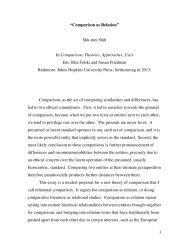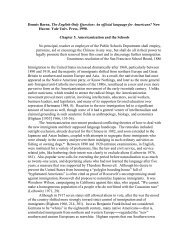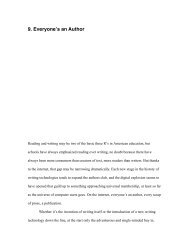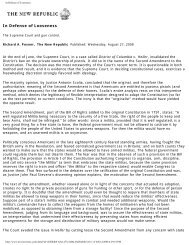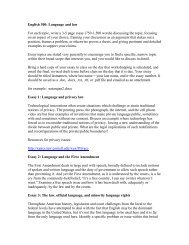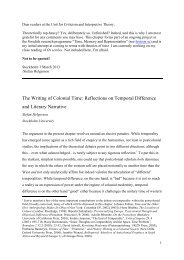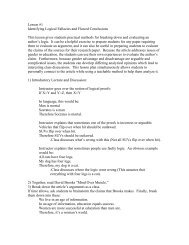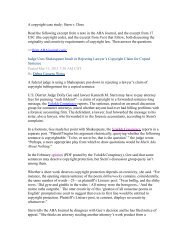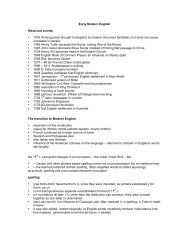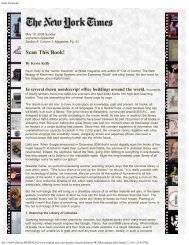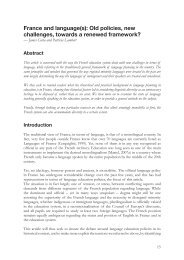Baron, Language <strong>and</strong> Law, <strong>1.</strong> <strong>Guns</strong> <strong>and</strong> grammar, 2For over 150 years, American courts interpreted this sentence as establishing<strong>the</strong> right of <strong>the</strong> people to possess arms when serving in <strong>the</strong> militia. This “collectiverights” interpretation underlay three Supreme Court decisions, <strong>the</strong> most recent ofwhich dates to 1939 (United States v. Miller 307 U.S. 174 [1939]). Miller had beenconvicted of transporting an unregistered sawed-off shotgun across state lines inviolation of a federal firearms law. He challenged <strong>the</strong> constitutionality of that law,<strong>and</strong> a lower court agreed. But <strong>the</strong> Supreme Court ruled that <strong>the</strong> <strong>Second</strong> Amendmentapplies to arms for military service, <strong>and</strong> Miller’s weapon did not come under itsauspices:In <strong>the</strong> absence of any evidence tending to show that possession or useof a “shotgun having a barrel of less than eighteen inches in length” atthis time has some reasonable relationship to <strong>the</strong> preservation orefficiency of a well regulated militia, we cannot say that <strong>the</strong> <strong>Second</strong>Amendment guarantees <strong>the</strong> right to keep <strong>and</strong> bear such an instrument.Certainly it is not within judicial notice that this weapon is any part of<strong>the</strong> ordinary military equipment, or that its use could contribute to <strong>the</strong>common defense.from <strong>the</strong> opinion in Miller by Justice McReynoldsThe collective rights interpretation also came into play in Parker: In hisopinion Judge Silberman notes that <strong>the</strong> lower court dismissed Parker’s initialcomplaint because<strong>the</strong> <strong>Second</strong> Amendment, at most, protects an individual’s right to“bear arms for service in <strong>the</strong> Militia” . . . . And, by “Militia,” <strong>the</strong> courtconcluded <strong>the</strong> <strong>Second</strong> Amendment referred to an organized militarybody—such as a National Guard unit.Parker v. Washington, D.C. (2007), 5But in 1960, opponents of gun control began asserting an alternate, individualrights interpretation, which ignored <strong>the</strong> militia clause <strong>and</strong> stressed every American’sright to tote a gun regardless of military service. In a rhetorical coup, <strong>the</strong>y evenstarted calling this new reading <strong>the</strong> “st<strong>and</strong>ard model,” as if <strong>the</strong> older collective rightsmodel had never existed (Bogus 2000b). The Appeals Court used this individualrights interpretation to rule Washington’s gun ban unconstitutional, arguing that <strong>the</strong>people referred to in <strong>the</strong> <strong>Second</strong> Amendment are individual citizens, a readingconsistent with interpretations of <strong>the</strong> people in <strong>the</strong> First <strong>and</strong> Fourth Amendments.Silberman exp<strong>and</strong>s on <strong>the</strong> Amendment’s semantics with definitions of keep <strong>and</strong> bearfrom <strong>the</strong> dictionaries of Samuel Johnson (1755) <strong>and</strong> Noah Webster (1828), <strong>and</strong> healludes to collections of newspaper <strong>and</strong> o<strong>the</strong>r writing of <strong>the</strong> time to maintain that,although <strong>the</strong> <strong>Second</strong> Amendment does connect bearing arms with <strong>the</strong> militia, <strong>the</strong>idiom bear arms does not refer just to soldiering:The term “bear Arms” is obviously susceptible to a militaryconstruction. But it is not accurate to construe it exclusively so.
Baron, Language <strong>and</strong> Law, <strong>1.</strong> <strong>Guns</strong> <strong>and</strong> grammar, 3Parker v. Washington, D.C. (2007), 24This interpretation is later echoed in Justice Scalia’s opinion in Heller (see below).Silberman also stresses <strong>the</strong> fundamental right of self defense. Although selfdefense is commonly recognized as a pre-existing, natural right affirmed by commonlaw <strong>and</strong> later by <strong>the</strong> <strong>Second</strong> Amendment, <strong>the</strong>re is also a long history of armsregulation in <strong>English</strong> law suggesting that self-defense is one thing, arms possessionis ano<strong>the</strong>r. Engl<strong>and</strong> has had strict weapons control since <strong>the</strong> 14 th -century, when lawsbegan stipulating that guns were for <strong>the</strong> wealthy, not <strong>the</strong> peasants or <strong>the</strong> middle class(Schwoerer 2000). The <strong>English</strong> Bill of Rights of 1689 is often cited by Americangun lobbyists as guaranteeing everyone’s right to bear arms <strong>and</strong> is referred to as wellin Parker <strong>and</strong> in Heller. But <strong>the</strong> <strong>English</strong> Bill of Rights limited weapons ownership toProtestants, provided <strong>the</strong>y belonged to <strong>the</strong> right social class, <strong>and</strong> it acknowledged <strong>the</strong>role of <strong>the</strong> law in fur<strong>the</strong>r regulating weapons: “That <strong>the</strong> Subjects which areProtestants may have Armes for <strong>the</strong>ir Defence suitable to <strong>the</strong>ir Conditions <strong>and</strong> asallowed by Law” (emphasis added).Above: Excerpt from <strong>the</strong> manuscript copy of <strong>the</strong> <strong>English</strong> Bill of Rights, 1689.British National Archives(http://www.nationalarchives.gov.uk/pathways/citizenship/rise_parliament/docs/bill_rights.htm). Below: Excerpt from <strong>the</strong> statement of rights as printed in 1689 (An actdeclaring <strong>the</strong> rights <strong>and</strong> liberties of <strong>the</strong> subject . . . , p. 5).In addition to interpreting words like “<strong>the</strong> people” <strong>and</strong> “bear arms,” JudgeSilberman concluded that its syntactic structure divided <strong>the</strong> amendment into a“prefatory” militia clause <strong>and</strong> an “operative” second clause: <strong>the</strong> first was a bit ofconstitutional throat-clearing that had no bearing on <strong>the</strong> right to bear arms. And so heruled that <strong>the</strong> operative clause prevented <strong>the</strong> city of Washington from imposing anabsolute ban on h<strong>and</strong>guns.The case was renamed District of Columbia v. Heller because <strong>the</strong> court ruledthat of <strong>the</strong> original plaintiffs, only Dick Anthony Heller, a D.C. special police officerwho had been denied a h<strong>and</strong>gun permit, had st<strong>and</strong>ing. In <strong>the</strong> appeal to <strong>the</strong> U.S.Supreme Court, opponents of gun control argued in part that <strong>the</strong>re are linguisticreasons for dismissing <strong>the</strong> first part of <strong>the</strong> <strong>Second</strong> Amendment, <strong>and</strong> <strong>the</strong>y interpreted
- Page 1: 1. Guns and Grammar: Determining wh
- Page 6 and 7: Baron, Language and Law, 1. Guns an
- Page 8 and 9: Baron, Language and Law, 1. Guns an
- Page 10 and 11: Baron, Language and Law, 1. Guns an
- Page 12 and 13: Baron, Language and Law, 1. Guns an
- Page 14 and 15: Baron, Language and Law, 1. Guns an
- Page 16 and 17: Baron, Language and Law, 1. Guns an
- Page 18 and 19: Baron, Language and Law, 1. Guns an
- Page 20 and 21: Baron, Language and Law, 1. Guns an



